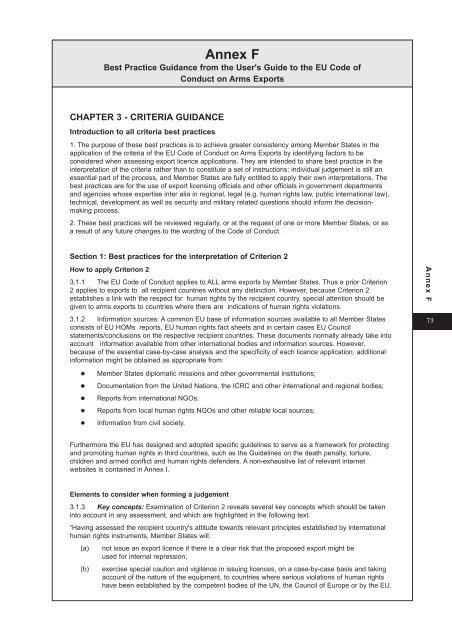Annex A - Official Documents
Annex A - Official Documents
Annex A - Official Documents
You also want an ePaper? Increase the reach of your titles
YUMPU automatically turns print PDFs into web optimized ePapers that Google loves.
<strong>Annex</strong> F<br />
Best Practice Guidance from the User's Guide to the EU Code of<br />
Conduct on Arms Exports<br />
CHAPTER 3 - CRITERIA GUIDANCE<br />
Introduction to all criteria best practices<br />
1. The purpose of these best practices is to achieve greater consistency among Member States in the<br />
application of the criteria of the EU Code of Conduct on Arms Exports by identifying factors to be<br />
considered when assessing export licence applications. They are intended to share best practice in the<br />
interpretation of the criteria rather than to constitute a set of instructions; individual judgement is still an<br />
essential part of the process, and Member States are fully entitled to apply their own interpretations. The<br />
best practices are for the use of export licensing officials and other officials in government departments<br />
and agencies whose expertise inter alia in regional, legal (e.g. human rights law, public international law),<br />
technical, development as well as security and military related questions should inform the decisionmaking<br />
process.<br />
2. These best practices will be reviewed regularly, or at the request of one or more Member States, or as<br />
a result of any future changes to the wording of the Code of Conduct.<br />
Section 1: Best practices for the interpretation of Criterion 2<br />
How to apply Criterion 2<br />
3.1.1 The EU Code of Conduct applies to ALL arms exports by Member States. Thus a prior Criterion<br />
2 applies to exports to all recipient countries without any distinction. However, because Criterion 2<br />
establishes a link with the respect for human rights by the recipient country, special attention should be<br />
given to arms exports to countries where there are indications of human rights violations.<br />
3.1.2 Information sources: A common EU base of information sources available to all Member States<br />
consists of EU HOMs reports, EU human rights fact sheets and in certain cases EU Council<br />
statements/conclusions on the respective recipient countries. These documents normally already take into<br />
account information available from other international bodies and information sources. However,<br />
because of the essential case-by-case analysis and the specificity of each licence application, additional<br />
information might be obtained as appropriate from:<br />
� Member States diplomatic missions and other governmental institutions;<br />
� Documentation from the United Nations, the ICRC and other international and regional bodies;<br />
� Reports from international NGOs;<br />
� Reports from local human rights NGOs and other reliable local sources;<br />
� Information from civil society.<br />
Furthermore the EU has designed and adopted specific guidelines to serve as a framework for protecting<br />
and promoting human rights in third countries, such as the Guidelines on the death penalty, torture,<br />
children and armed conflict and human rights defenders. A non-exhaustive list of relevant internet<br />
websites is contained in <strong>Annex</strong> I.<br />
Elements to consider when forming a judgement<br />
3.1.3 Key concepts: Examination of Criterion 2 reveals several key concepts which should be taken<br />
into account in any assessment, and which are highlighted in the following text.<br />
“Having assessed the recipient country's attitude towards relevant principles established by international<br />
human rights instruments, Member States will:<br />
(a) not issue an export licence if there is a clear risk that the proposed export might be<br />
used for internal repression;<br />
(b) exercise special caution and vigilance in issuing licences, on a case-by-case basis and taking<br />
account of the nature of the equipment, to countries where serious violations of human rights<br />
have been established by the competent bodies of the UN, the Council of Europe or by the EU.<br />
<strong>Annex</strong> F<br />
73

















